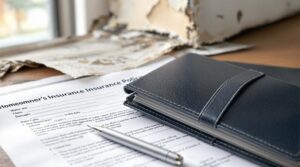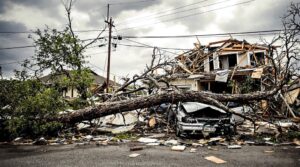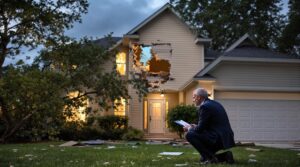Home insurance typically covers tree damage when it affects insured structures and results from covered perils like storms, wind, or lightning. Coverage includes repair costs for damaged buildings and limited tree removal expenses, usually up to $1,000. However, damage from poorly maintained or diseased trees may be denied coverage. Claims should be filed regardless of tree ownership, though liability can depend on maintenance history. Understanding specific policy terms and maintenance requirements helps guarantee maximum coverage protection.
Key Takeaways
- Home insurance covers tree damage only when it affects insured structures like your house, garage, or fence.
- Coverage typically includes repair costs for structural damage and up to $1,000 for tree removal.
- Trees that fall without damaging insured structures generally aren't covered by home insurance.
- Insurance covers damage from natural causes like wind or lightning, but not from negligent maintenance or dead trees.
- Claims should be filed with your own insurance regardless of tree ownership, with coverage limits usually set at 5% of dwelling coverage.
Understanding Tree Damage Coverage in Home Insurance
When a tree falls on or near a property, understanding the specifics of home insurance coverage becomes crucial for homeowners. Coverage primarily depends on whether the tree damages an insured structure and the cause of its fall.
Insurance policies typically cover sudden and accidental events, such as trees toppled by wind, lightning, or hail. The condition of the tree is a critical factor in coverage determination. Insurance adjusters evaluate tree health prior to the incident, as damage from dead or poorly maintained trees may be denied coverage.
While policies generally provide $500 to $1,000 for removal when a tree damages insured structures, removal costs without structural damage are typically not covered. Notable exceptions exist when fallen trees block essential access points like driveways or handicap ramps.
Additionally, standard policies exclude coverage for yard damage, gradual deterioration, and trees that fall due to preventable causes like inadequate maintenance. Claims are filed by the property owner who sustained damage, regardless of tree ownership.
When Your Home Insurance Will Pay for Tree Damage
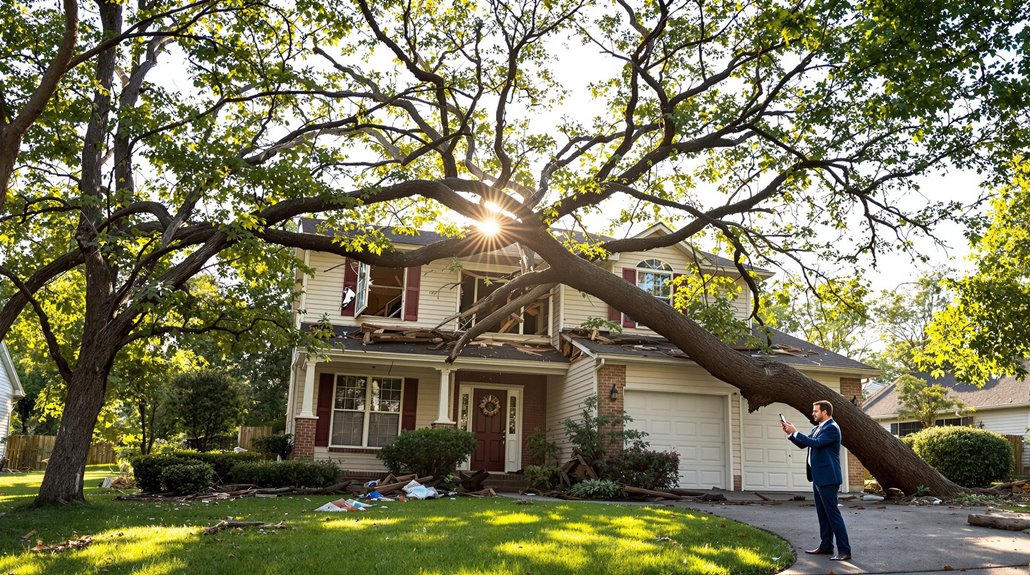
Homeowners insurance typically covers tree damage under specific circumstances that align with standard policy terms and conditions. The coverage extends to damage caused by fallen trees to the dwelling and other insured structures when the fall results from covered perils such as wind, lightning, or vehicle impact not involving the resident.
Insurance policy nuances dictate that coverage depends on the cause of the fall rather than tree ownership. During tree damage assessment, insurance adjusters evaluate whether the incident resulted from natural causes or negligence.
Coverage includes repair costs for damaged structures and often provides $500 to $1,000 for tree removal when the tree has impacted a covered structure. However, damage solely to landscaping or trees falling without striking insured structures typically remains uncovered.
Additionally, if negligence in tree maintenance contributed to the fall, insurers may deny claims or pursue subrogation against the tree owner's insurance company.
Common Tree Damage Scenarios Not Covered by Insurance
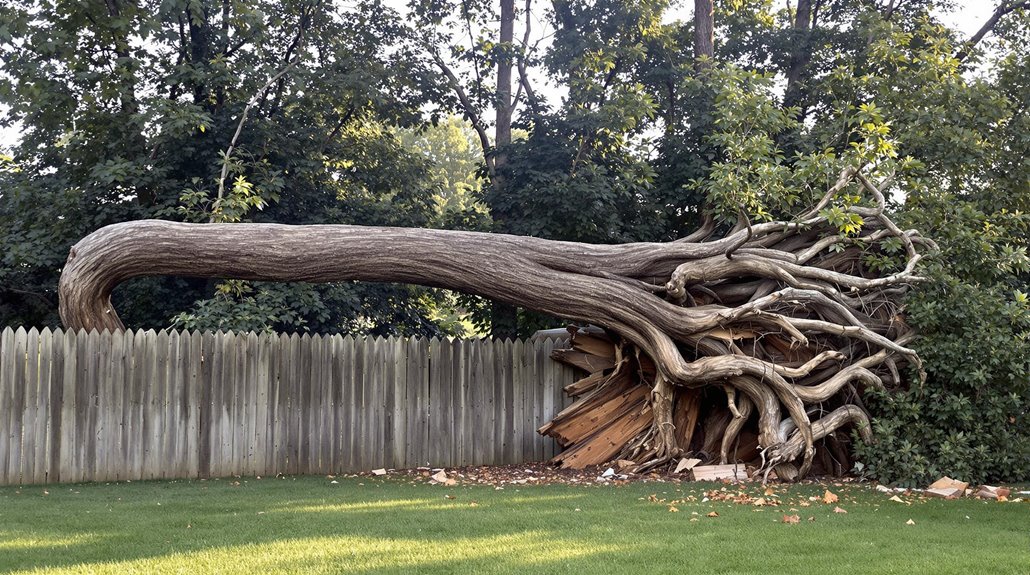
Insurance companies typically deny coverage for tree damage resulting from negligent maintenance, such as failing to remove dead, diseased, or rotting trees.
When trees fall due to age-related deterioration or decay without any storm involvement, homeowners find themselves responsible for both removal costs and any resulting property damage.
Natural processes like root rot or gradual deterioration are considered preventable conditions that fall outside standard insurance coverage, making it essential for homeowners to maintain their trees properly.
Neglect and Natural Decay
In contrast to sudden storm damage, natural decay and neglect represent significant tree-related risks that standard home insurance policies typically exclude from coverage.
Insurance providers expect homeowners to fulfill their maintenance responsibilities by monitoring tree health and addressing issues before they cause damage.
Trees showing signs of disease, rot, or decay fall under maintenance obligations rather than insurance protection.
Similarly, gradual damage from root systems or untreated tree diseases is excluded from coverage, as insurers consider these issues preventable through proper care.
Insurance companies will not cover the cost of removing dead or diseased trees unless they have damaged insured structures, and even then, coverage limits typically range from $500 to $1,000.
Neglecting visible signs of decay can result in denied claims when damage occurs.
Storm-Free Tree Falls
When trees fall without storm-related causes, property owners often face significant challenges with insurance coverage.
Standard homeowners insurance typically excludes coverage for trees that fall due to preventable circumstances or natural deterioration. Insurance carriers generally require evidence that tree damage resulted from a covered peril rather than negligence or decay.
Key scenarios where tree insurance claims are commonly denied include:
- Trees that fall due to disease or rot without damaging insured structures
- Removal of fallen trees that only cause lawn or landscaping damage
- Trees that collapse due to age-related deterioration or lack of maintenance
- Debris cleanup from fallen trees that don't obstruct essential access points
Understanding these exclusions helps property owners recognize their responsibility to maintain trees and prevent potential issues through regular inspections and proper care.
Essential Tree Maintenance to Prevent Insurance Claims
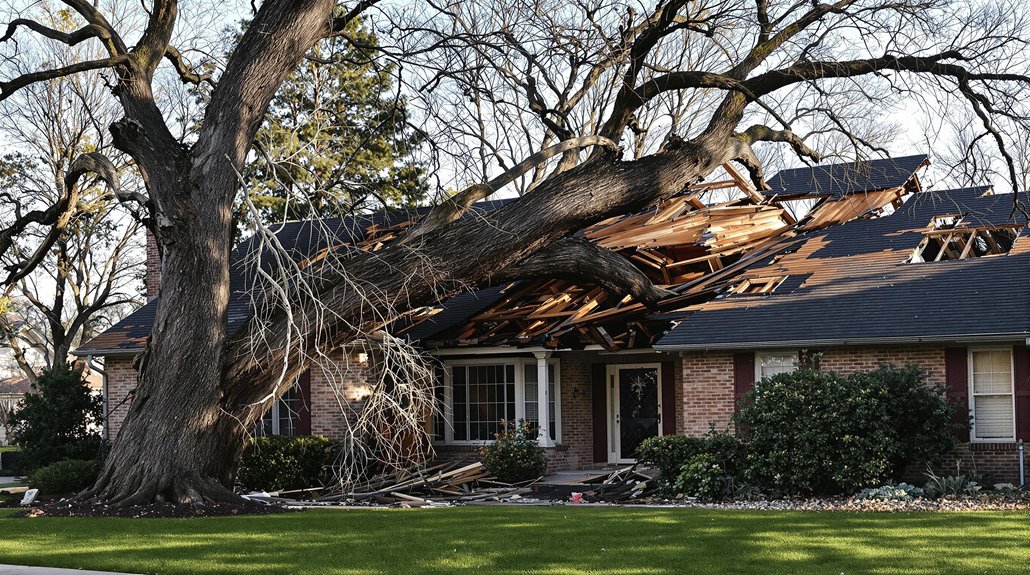
Regular tree inspections conducted by qualified arborists serve as a critical foundation for preventing insurance claims related to fallen trees and branches.
A thorough inspection schedule should assess structural integrity, disease presence, and potential hazards while documenting findings for insurance records.
Following professional assessment, property owners must implement recommended maintenance practices, including proper pruning techniques, root system monitoring, and immediate removal of damaged or diseased branches to maintain peak tree health.
Regular Inspection Schedule
Maintaining a systematic tree inspection schedule stands as a cornerstone of responsible homeownership and insurance compliance. Regular evaluations conducted by certified arborists help assess tree health and identify potential hazards before they result in costly damage or insurance claims.
Key inspection benefits include:
- Documentation for insurance purposes through detailed record-keeping of maintenance activities
- Early detection of structural issues like cracks, hollow trunks, or unstable root systems
- Seasonal assessment of tree condition changes throughout the year
- Professional evaluation of proximity risks to structures and property
These systematic inspections align with insurance policy requirements and demonstrate proactive risk management. Certified arborists provide expert assessments that can identify issues requiring immediate attention, from necessary pruning to complete tree removal, helping homeowners maintain both their property's safety and insurance coverage.
Tree Health Best Practices
Every successful tree maintenance program incorporates essential health practices that considerably reduce the likelihood of insurance claims due to tree failures or property damage.
Proper tree pruning during dormant seasons, combined with regular soil health monitoring through pH testing and appropriate fertilization, forms the foundation of preventive care. Maintaining 2-4 inches of organic mulch around trees while keeping the trunk clear helps regulate moisture and temperature.
Disease management requires consistent sanitation practices, including clean pruning tools and prompt removal of plant debris.
Protection against pests involves regular inspections for damage signs and maintaining a weed-free zone around the trunk.
Implementing deep watering techniques through soaker hoses or drip irrigation systems encourages strong root development, while proper soil aeration guarantees adequate drainage and prevents compaction issues.
Steps to File a Tree Damage Insurance Claim
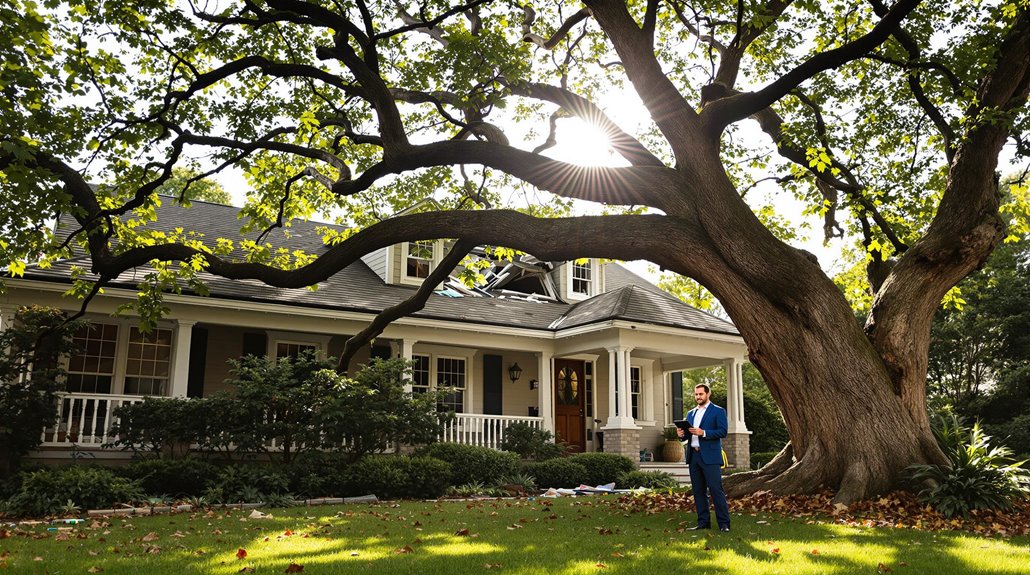
Filing an insurance claim for tree damage requires a systematic approach to secure proper documentation and maximum coverage.
When a tree falls and causes property damage, homeowners should immediately document the scene with photos and videos while reviewing their policy terms. Proper claim submission involves notifying the insurance company promptly and scheduling an insurance adjuster to assess the damage professionally.
Key steps for a successful tree damage claim:
- Document all damage thoroughly with detailed photos and gather repair estimates from licensed contractors.
- Review policy coverage, including specific perils and exclusions related to tree damage.
- Submit complete claim forms with supporting documentation to the insurance company.
- Cooperate with the adjuster's assessment and follow up regularly on claim status.
Understanding policy limits and maintaining clear communication throughout the process helps secure fair compensation for repairs and restoration of the damaged property.
Dealing With Neighbor's Trees and Insurance Claims
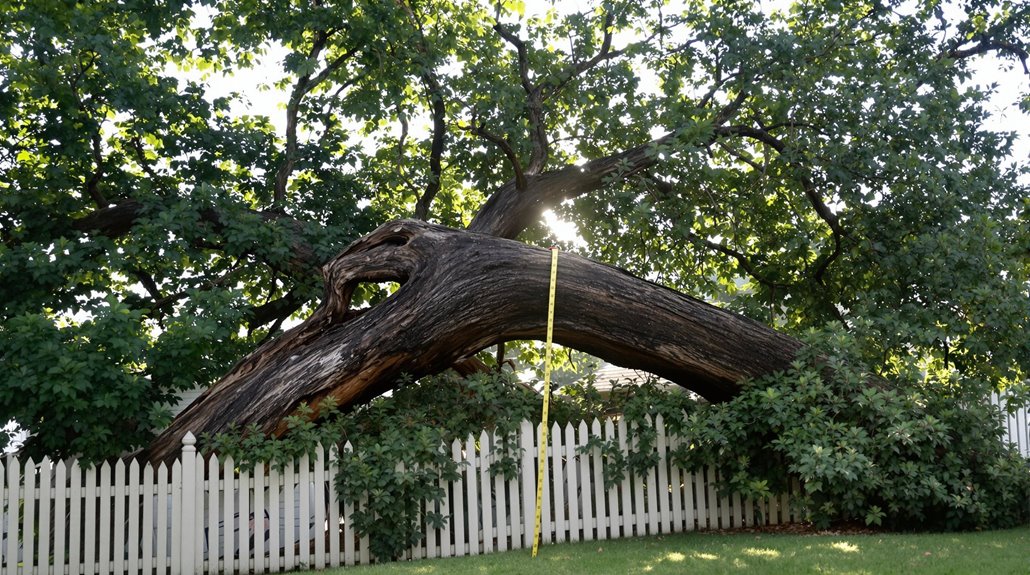
When trees from a neighboring property cause damage, homeowners often face complex insurance and liability questions that require careful navigation. The standard procedure is for property owners to file claims with their own insurance company, regardless of tree ownership.
Through a process called subrogation, the insurance company may then seek reimbursement from the neighbor's insurer if negligence can be proven.
Neighbor liability typically hinges on whether the tree was healthy or diseased. While no one is generally liable when healthy trees fall due to natural causes, property owners can be held responsible if they knew about diseased or unstable trees but failed to address them.
Tree responsibilities include regular inspections and maintenance to prevent potential hazards. Homeowners concerned about neighboring trees should document the situation with photographs and written communication.
For added protection, obtaining a professional arborist's assessment can provide vital evidence if disputes arise about the tree's condition before damage occurred.
Coverage Limits for Tree and Plant Damage
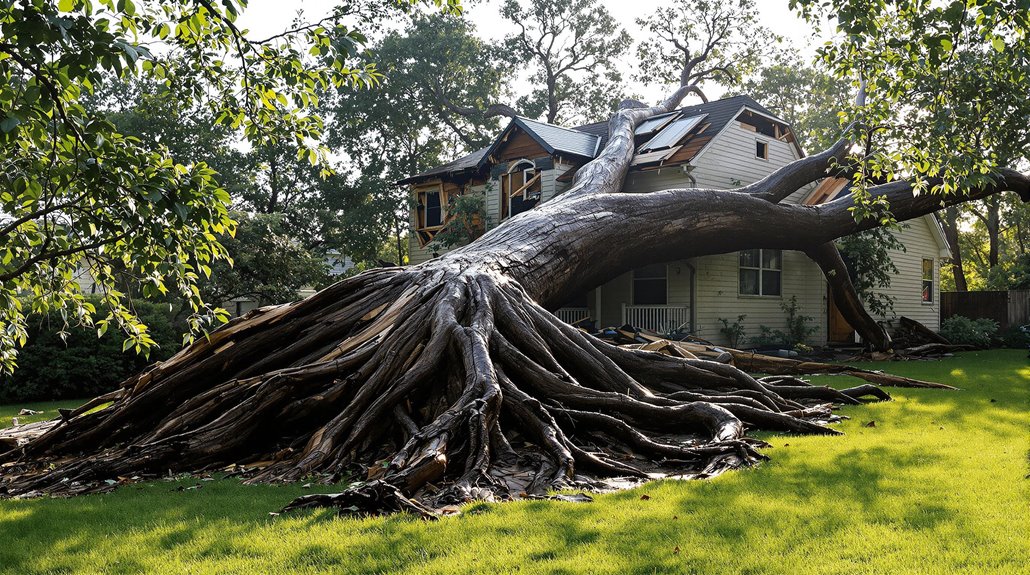
While understanding liability for fallen trees is important, homeowners must also be aware of specific coverage limits for tree and plant damage in their insurance policies. Standard policies typically limit coverage to 5% of the dwelling coverage amount, with insurance caps applying to individual trees, shrubs, and plants.
Tree removal costs are usually restricted to $500-$1,000 per incident, depending on the insurer.
Key coverage restrictions homeowners should know:
- Insurance only covers damage from specific perils like fire, lightning, theft, and vandalism.
- Trees falling without damaging insured structures are generally not covered.
- Damage from rot, decay, or poor maintenance is excluded.
- Trees grown for commercial purposes require separate business coverage.
Additional coverage may be available for high-value landscaping, but standard policies maintain strict limits.
When filing claims, homeowners must specify the type of peril that caused the damage, and coverage decisions are subject to adjuster evaluation.
Special Cases: Vehicles, Commercial Trees, and Access Points

Special cases involving fallen trees require distinct insurance considerations depending on the circumstances of damage.
When trees are damaged by vehicle collision, coverage typically applies if the vehicle belongs to someone other than the property residents. The damage falls under personal property coverage due to named perils, with removal costs generally capped between $500 and $1,000.
Commercial properties face different scenarios with specific commercial exclusions. Business owners need separate insurance policies for trees grown for commercial purposes, covering weather-related and accidental damage but not neglect.
Tree removal costs are only covered if property damage occurs. Regarding access points, insurance may cover removal if trees block driveways or handicap-accessible ramps.
However, standard policies typically exclude removal costs for trees that haven't damaged insured structures. Property owners must carefully review their policies to understand coverage limitations and requirements for these special circumstances.
Best Practices for Tree Risk Management
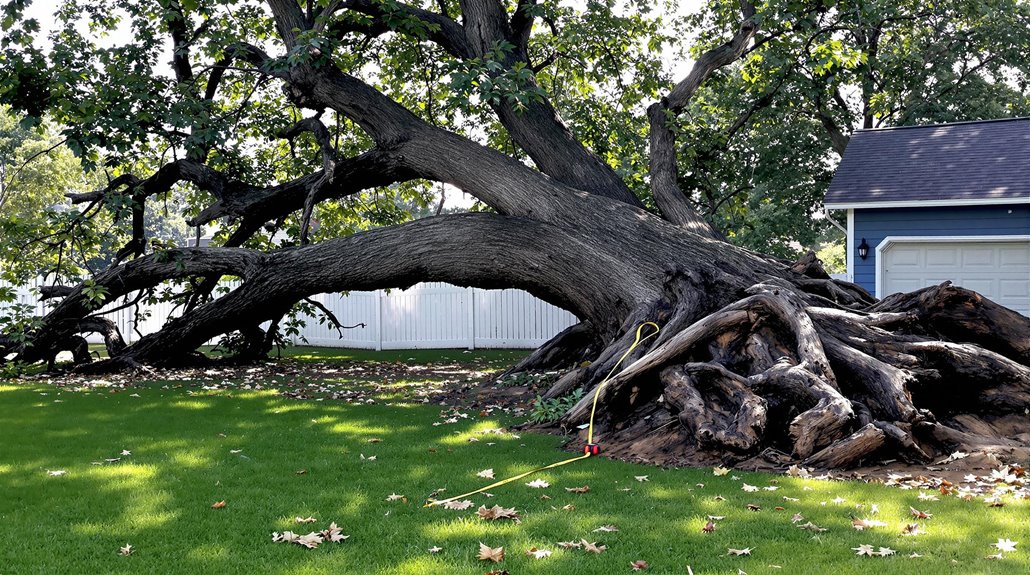
Beyond addressing insurance coverage for fallen trees, property owners must implement thorough tree risk management strategies to prevent damage and reduce liability. Regular inspections performed by qualified arborists every 5 years, along with extensive documentation of findings, form the foundation of effective risk management. This systematic approach enables early detection of potential hazards and appropriate mitigation measures.
Key elements of a robust tree risk management program include:
- Conducting both qualitative and quantitative assessments using advanced technology like sonic tomography.
- Evaluating site-specific factors such as soil conditions, wind exposure, and species characteristics.
- Maintaining detailed records of inspection frequency, findings, and subsequent actions taken.
- Implementing appropriate mitigation measures through proper pruning and structural support systems.
Property owners should also consider target assessment, identifying valuable assets that could be impacted by tree failure. Understanding local environmental conditions and establishing standardized inspection practices further enhances the effectiveness of risk management strategies.
Frequently Asked Questions
Can I Claim Insurance if Lightning Strikes My Tree Without Damaging Structures?
Homeowners insurance typically covers lightning damage to trees, but coverage is often limited to 5% of the dwelling's insured value and may not include removal costs unless structures are damaged.
Does Insurance Cover Tree Damage Caused by Burrowing Animals or Insects?
Homeowners insurance typically excludes tree damage caused by burrowing animals or insect damage, as these are considered preventable maintenance issues. Such damages fall under standard policy exclusions for pest-related problems.
Will Insurance Cover Replacement of Rare or Expensive Ornamental Trees?
Insurance coverage for rare ornamental tree replacement typically applies only for specific named perils. Policy specifics determine valuation limits, while standard coverage excludes weather damage, pests, and diseases.
Are Tree Root Damages to Underground Pipes Covered by Home Insurance?
Standard homeowners insurance does not cover tree root damages to underground pipes, as this is considered preventable damage. Root damage assessment and tree maintenance costs remain the homeowner's responsibility.
Does Insurance Cover Emergency Tree Removal During an Ongoing Storm?
Want to know about urgent tree situations during storms? Insurance typically covers emergency services for tree removal only when storm damage affects insured structures, not for preventive or ongoing removal operations.
Final Thoughts
Like a wise gardener who plans for both sunshine and storms, prudent homeowners understand that tree coverage in insurance policies requires careful cultivation. Just as nature follows its own rules, insurance policies have specific parameters for tree-related claims. By maintaining trees properly and understanding policy details, homeowners can weather the unexpected, ensuring their property remains protected against nature's unpredictable forces.
For homeowners dealing with tree-related damage or any property damage covered by their homeowners insurance policy, insurance industry experts and legal professionals strongly advise consulting a qualified state-licensed public adjuster. These professionals work exclusively for policyholders, not insurance companies, serving as dedicated advocates throughout the claims process. Public adjusters possess the expertise to identify hidden damages often unknown to policyholders, thoroughly document losses, and negotiate effectively with insurance companies to secure fair settlements while protecting policyholder rights.
By engaging a public adjuster, homeowners can maximize their claim settlements, expedite the claims process, and reduce the stress of managing complex insurance matters. For those seeking expert assistance with property damage claims, the Public Claims Adjusters Network (PCAN) offers free, no-obligation consultations with licensed public adjusters who can evaluate your situation and guide you through the claims process.


